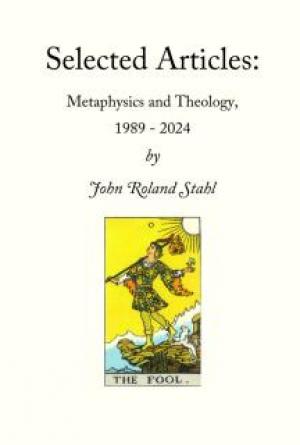Introduction
In this article, I will relate the ancient Indian teaching on the three gunas to energy qualities that are expressed in the human psyche, or brain-mind. Some examples will be given that can be of therapeutic use.
Also, I will present some cybernetic diagrams of the perception-feeling-emotion process action-loop that tie in with the idea of the gunas. Much is still to discover about said process, and these diagrams are just a first step in gaining more understanding of it.
The three gunas
The three gunas are: sattva, rajas, tamas. Briefly stated, sattva designates balanced use of energy, rajas means activity and tamas passivity or inertia. There is a deeper explanation of these gunas which is not well-known. It has to do with the simultaneous working of these qualities, and their relative dominance. For example: pure tamas (tamas in the tamas condition) can be equated with passivity in a negative sense. However, tamas can be in a higher condition (sattvic, balanced) which equates with persistence and steadfastness, which have a positive connotation. The same applies to rajas: pure rajas is uncontrolled, raw energy, while controlled rajas (in a sattvic condition) is an expression of wise use of observing ability plus well-directed energy. This explanation is rarely given in standard texts. Yet, it makes much sense, as you will see when studying the following diagrams.
101
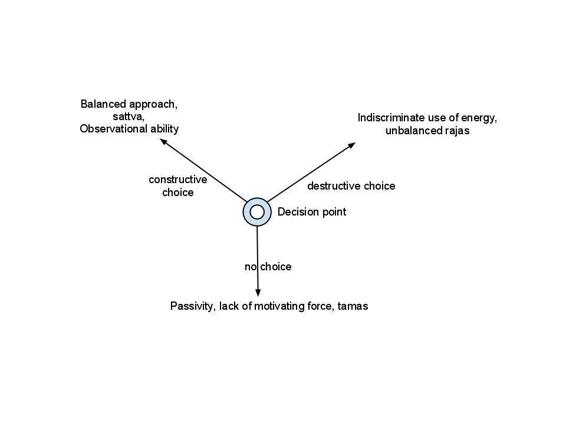
Fig. 1: polarities and the gunas.
102

Explanation of fig. 1.
The process starts at the decision point. This simply is a state of mind, brought about by some psychic energy, as you will see in the next figures. It can be anger, or jealousy, or fear, or any other activation of an emotional state of the mind. This state calls for some resolution, some action, some decision or choice to be made.
The balanced approach, a constructive decision, requires some observational ability. It is something that may take longer to do, or may require more patience, than the unbalanced approach which is often destructive or missing the mark.
There also is a possibility that one does not choose to do anything at all. One remains passive, which usually means that one ends up being controlled by one's instincts and impulses, or at the mercy of the environment and other people.
To make this a bit clearer, let's have a look at some concrete examples of psychological energies at work. See figs. 2, 3, 4.
Fig. 2: How anger is resolved.
103

104
Explanation of fig. 2.
Anger is seen here as a signal of the psyche (from the subconscious to the conscious) that something is not well. Typically, some kind of hurt from outside impinges on one's boundary. It can be something that someone says to you, or an unpleasant look or gesture.
Anger is not a negative energy. It is a neutral energy, whose function it is to alert you to some hurt, or a signal that some need is not met.
The mature reaction to anger is to assert your needs, and to assert your boundary.
Stating that you don't like something someone just said to you is a mature thing to do. (If it doesn't touch you, then you probably will just ignore the message.) Being able to say no, is a mature thing too. And being able to hear no, is a mature thing as well. Aggression, in the modern use of the word, means an inappropriate use of energy. It almost always leads to hurting another person. Most likely, the other will try to retaliate, which may lead to a vicious cycle of verbal and/or physical violence. Not a healthy situation.
There is also the possibility that one does not make a choice in dealing actively with the signal that the subconscious is giving you (as the conscious operator or ego). This will result in a state of depression or feelings of sadness. This is needless suffering, and one will remain in this state until the lesson, implicit in the situation, is learned.
Another example of psychological energies at work is given in fig. 3: the resolution of fear
105
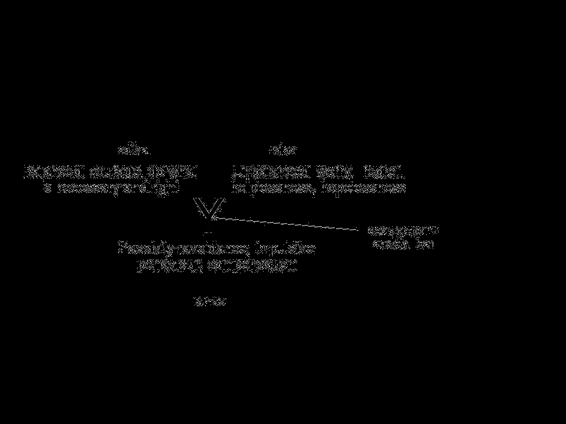
Explanation of fig. 3.
Here, the signal is fear or a state of anxiety. The only positive resolution of this state is to do what is needed (and right), in a given situation. One can call this courage, without the association of a knight going to war. Fears can be many: fear of losing one's job, fear of losing one's partner (see next figure), fear of contracting a disease, etc.
Dealing constructively with fear requires facing the situation one is in with an open, observing mind. See the possibilities that are open to you at any moment in time, and weigh your options. It does not help to keep worrying about what could happen to you. It is a waste of valuable energy and leads to suffering. Another option is to put your head into the sand, like an ostrich, and avoid any consideration of options. It is more than likely that you will regress into compensatory behavior: overeating, addictions to alcohol, work, drugs. Panic may set in too.
Another example is given in fig. 4: resolution of jealousy 106
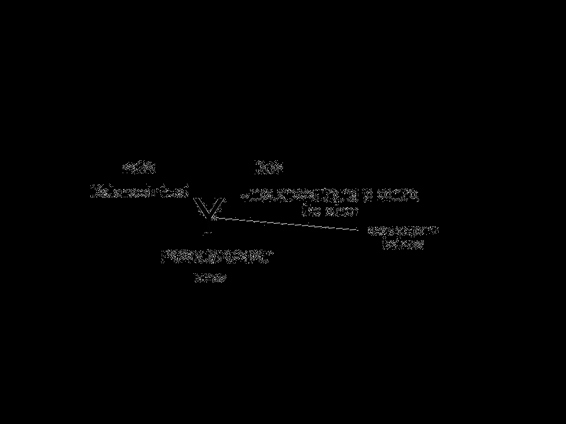
Explanation of fig. 4.
By now, you may have got an inkling of how various psychological energies are related to decision making. There is a balanced way to do things, an unbalanced way (missing the mark) and a passive attitude, which leads to suffering, like the unbalanced way. In the case of jealousy, let's say about a partner, or potential partner, who you see in company with someone of the opposite sex (or same sex, if you are gay or lesbian), there are choices you can make. The balanced way is to trust the other person. That is: you realize that you don't possess the other. You cannot decide what is right for the other.
How could you? The other has a right to lead his or her own life. You may be a part of it, or you may not. If you think otherwise, and try to control the other, say by forcing him or her to stay with you at home, or always trying to accompany him or her (“babysitting”), what will you accomplish? Probably the exact opposite of what you want. Grudges will arise on the part of the other and you may very well lose him or her.
107
When feeling jealous, fear of losing a desired one, it will not help to stay in a passive state.
This will lead to despair. This is because you don't trust the other (your partner) and cannot engage in controlling him or her. Both are options that will not help you forward in your life. It is much better and sound to start trusting life. This attitude will give you peace of mind and is part of a positive, constructive way of dealing with situations. Using and developing your observing skills will serve you well.
Some further ideas
There are many subtle points that can be made here. I can only touch upon some here.
For example, passivity of mind should not be confused with receptivity. The latter can be a very necessary state of mind: being open to ideas, suggestions, and possibilities of a situation, etc.
A balanced use of psychological energy often requires a somewhat developed observational skill, not in the least: the skill of self-observation. It will be clear that there are mature levels of functioning and immature levels, as expressed in the diagrams. Passivity seems to me to be the least mature way of reacting, while indiscriminate use of psychological energy also classifies as immature (but will get you strong reactions from others, in this case, and you might learn a thing or two about yourself). The most mature way of decision making is the balanced way, involving good judgment, life experience, and a high moral standard.
Constructive use of psychological energies leads to self-confidence, well-being and the like.
Self-esteem is associated with this. This is a matter of personal growth.
Another thing concerns the use of graphs. What I have presented here are graphs of pathways of decision, and associated states of mind. Graphs like these can be combined. For example, graphs of two persons who are interacting with each other can be combined. These will portray feedback cycles. Does one reinforce codependency, for example? Or do two people reinforce mutual balanced growth? Interaction with the environment can be modeled likewise, giving some flow-diagrams of needs that are being met or fulfilled. The possibilities seem endless, and more research into this area is necessary.
It all fits into a process philosophy and model of psychological forces at work. Perhaps the same diagrams can be used in other domains, like biology. This is an open question.
Last, but not least, my gratitude goes to Dr. Paul Dobranski, whose work on MindOs has been very helpful in developing these ideas. The work on the gunas, however, is strictly mine, and so are the diagrams in the specific form that I have given them, combining gunas with psychological energies. As you will notice, my work falls under a creative commons license, which allows other people to make use of it under the associated conditions.
108
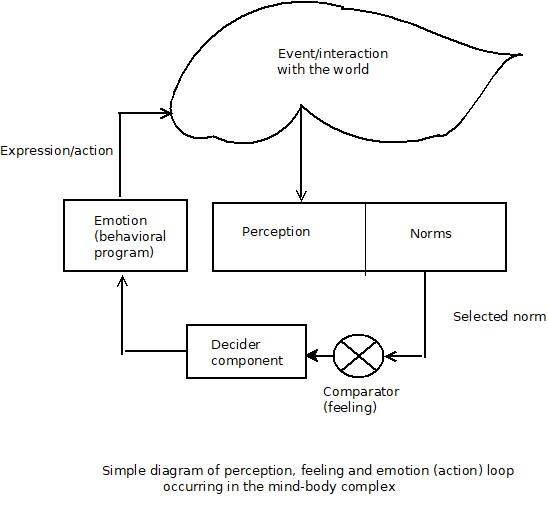
Addendum
Two Cybernetic diagrams of the perception-feeling-emotion action-loop
After rereading Stafford Beer's book “The heart of enterprise”, I got the idea of drawing cybernetic diagrams of the process of perception, feeling, emotion and decision. This is work in the beginning stage. Nevertheless, these diagrams can be helpful in understanding some of the complexities of said process.
The first diagram shows how perception of an event leads to an evaluation of the significance or meaning of the event. This involves the use of a norm (mostly learned by education, nurture, etc.), necessary to compare what's happening to oneself with what is expected or deemed appropriate in a given situation. The evaluation process involves as its outcome feelings, a matter of the heart or gut, metaphorically and perhaps literally speaking.
109
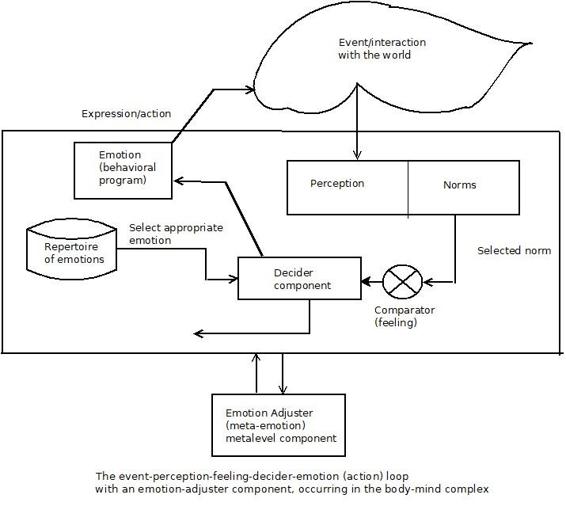
Emotions are something else: they resemble action programs, some being instinctive, others being acquired by growing up in society. Emotions are reactions, expressions of how one feels about things. Much of this is subconscious (body language).
The decider component has to with choice, selection of an appropriate emotional response.
The following diagram shows this selection more clearly.
In this diagram it is shown that an appropriate emotion is chosen from a repertoire. That should be typical for a civilized person. Now, when, on second thought (the emotion adjuster box), the emotion does not seem that adequate, the decider having been too 110
impulsive, a correction is made to the behavior. Maybe an excuse of some sort, or a clarification of one's feelings.
There is a double line between the emotion adjuster box and the rest of the system (shown in the large box) to indicate that the adjuster works on the whole of perception, comparator and decider components. The adjuster fulfills a meta-function. It is of a higher order. The whole system of perception, etc., is very complicated. What is shown here is a global picture. Details have to wait until further examination.
Appendix C: Light on the sacraments
111
The hidden or esoteric meaning of the seven sacraments by Martin Euser
(edited, august 2020)
In this short article I will compress some information from diverse sources on the sacraments. Also, the symbolism of Bread and Wine will be concisely dealt with.
First of all, I have no problem with religion or religious practice, provided it be true to the true meaning and goal of religion: helping people to establish a bond with the Divine, especially the divine within them and the divine in others.
Religion, properly understood, provides a moral basis for life.
While humanism, as a philosophy and practice is fine, it cannot provide a solid basis or principle for daily life. There are simply too much questions humanism, atheism, etc., can't deal with, because lacking in insight in the structure of the human being.
History shows that a religion usually degenerates relatively quickly, when its founder has died. A priest caste takes over, establishing power over the masses. Doctrines are taken literally, twisted, or wrongly applied. The same has happened with the sacraments in Christianity.
It may be profitable when you study chapter 13 and a bit of chapter 14 of Jacob Boehme's book "The threefold life of man" (free ebook in my archive).
Boehme criticizes the distortions that have crept in the understanding and application of the sacraments and the pretensions of priests and pastors.
Undoubtedly, many people will have asked themselves, while in a contemplative mood, "what is the meaning of this ritual, be it the Eucharist, Baptism, or some other Sacrament. Is it literally "the body of Christ" that we are eating or His blood that we are drinking?
And what about infant baptism? After all, the infant has not him- or herself chosen to be a follower of this or that Christian 112
denomination, so, what is happening there? And what about the Confession, or forgiveness of sins?
These are good questions, and they are never satisfactorily answered by church officials. There is a good reason for that:
they can't. If they would know the true background of these rituals (sacraments) they very likely wouldn't want to tell you, and if they didn't know, they couldn't. You will readily understand this statement when you read on.
The truly religious person, in the true catholic, universal sense, cannot help but to probe into the depths of Being and try to understand what their religion is about, whence it came, how it has changed (councils of Nicea and Constantinople), and, what recent discoveries have been made (Dead sea scrolls. Nag Hammadi Gnostic scrolls, etc.). One would expect a massive interest in these things, but in reality the interest of many Christians is not so much aroused. Why?
Are people being a little lazy? Afraid? Is it the comfort of having a certain circle of friends in a religious community that one wants to keep? Is it the discouragement of the churches regarding asking questions?
Whatever be the case, the call of the Spirit within inevitably leads one to follow the path within, be it in this incarnation or another.
Let's start dealing with the Sacraments now. I take the order and naming (translated) that one can find in lit. 1.
From my sources about Christianity (D.J.P. Kok, lit. 1; De Purucker, lit.3, Vitvan, lit. 5), I can state the following condensed points about the sacraments. These points applied to the mystery schools of old, and still apply today, on the inner planes of being, without necessity of outer ceremony or rite.
The world has changed, and much what has been "esoteric", hidden to the profane, has now become available to the educated masses, especially the so-called "lesser mysteries" have become available as teachings in the School or Order that I follow, and these teachings pertain to the first three sacraments.
113
The sacraments have to do with one's orientation on life, moral development, and choice to work for the benefit of general humanity. They pertain to spiritual evolution.
In my humble estimation, the seeker for wisdom would do well to consider joining an organization that works for the benefit of the human race, and all other life, in order to be able to connect better with other like-minded individuals, establish a nurturing environment, and help maintain one's orientation to the spirit within.
1. The Baptism with water
In the mystery schools of old, the baptism with water pertains to instruction in the wisdom teachings, the perennial philosophy, or Gnosis; It is also symbolic for changing one's orientation to life.
A change from orientation on the outward world, the sense-world (being a so-called Hylic) to an orientation on the psychic world, the energy world within (compare Vitvan on the First Crossing). Note the clever choice of water as a symbol of cleansing off the dirt (earth) from one's body and especially one's mind; also, water is a symbol for the psychic world; the fluid nature of both is apparent.
The increase in the number of "Psychics", that is: people who are starting to seek meaning within rather than without is the main reason for writing this little article. The Hylics don't care, and the Self-realized (where Pneuma or Spirit is active) already know these things.
This sacrament is also very much about the application of the instructions in daily life. After all, without practicing what one has learned, no lasting experience can be gained.
Instructions are like pointers or signposts on the way. They are helpful, but the individual has to walk the path, do the work, take decisions him-or herself.
No imposition of rules of conduct is applied, the aspirant has an autonomous will and chooses to follow the spiritual path him- or 114
herself. No vicarious atonement. See also the sacrament of Confession.
From the Freke-Gandi book:
"LEVELS OF INITIATION
Both Pagan and Gnostic philosophical systems described four levels of human identity: physical, psychological, spiritual and mystical. Gnostics called these four levels of our being the body, the counterfeit- spirit, the Spirit and the Light-power. The body and the counterfeit- spirit (our physical and psychological identities) make up the two aspects of the eidolon or lower self. The Spirit and Light - power (our spiritual and mystical identities) make up the two aspects of the immortal Daemon -
the individual Higher Self and the shared Universal
Self.
The Gnostics called those who identified with their body 'Hylics', because they were so utterly dead to spiritual things that they were like unconscious matter, or hyle. Those who identified with their personality, or psyche, were known as 'Psychics'. Those who identified with their Spirit were known as 'Pneumatics', which means 'Spirituals'.
Those who completely ceased to identify with any level of their separate identity and realized their true identity as the Christ or Universal Daemon experienced Gnosis. This mystical enlightenment transformed the initiate into a true 'Gnostic' or 'Knower'.
In both Paganism and Christianity these levels of awareness were symbolically linked with the four elements: earth, water, air and fire. The initiations leading from one level to the next were symbolized by elemental baptisms. In The Book of the Great Logos
, Jesus offers his disciples 'the Mysteries of the three baptisms' by water, air and fire.
Baptism by water symbolizes the transformation of the Hylic person, who identifies solely with the body, into a Psychic initiate who identifies with the personality or psyche.
115
Baptism by air symbolizes the transformation of the Psychic initiate into a Pneumatic initiate who identifies with their Higher Self.
Baptism by fire represents the final initiation which reveals to Pneumatic initiates their true identity as the Universal Daemon, the Logos, the Christ within, the 'Light-power' - 'the true Light which lighteth every man that cometh into the world', as John's gospel puts it. Such an initiate had realized Gnosis.
These, then, are the levels of initiation in Gnostic Christianity." (end of quote)
2. The Confirmation
When the aspirant has progressed on the Path, he or she gets ready for the second sacrament: the Confirmation. This is a Formation in a sense. It confirms what one has formed oneself into by the first sacrament.
It refers to commitment to the Way within, the Path; the Journey. It
refers to steadfastness in Faith. No concessions to outer pressures, sentiments and opinions of the world. Taking the inner decision to really follow the Path of spiritual evolution.
More and deeper instruction is given to the aspirant or neophyte, in former days as a member of a mystery school, but nowadays more integrated in regular structures. The so-called lesser mysteries, which pertain to the first three sacraments, and concomitant teachings, have become freely available to the public at large, through various channels, among which theosophical ones and related schools.
My e-books give a good introduction to these teachings.
3. The Eucharist, Oblation or Communion
116
See the section on bread and wine (or grape juice) symbolism. This sacrament refers to communion with the Spirit and the world, as manifestation of Spirit.
In the mystery schools of old, it was the communion of the disciples, being one in heart and mind. Living in feeling of unity with and of all life. Consciousness in the disciple grows strong that the outer world is an expression of the Divine. Living in a feeling of non-separation.
Also, this pertains very much to the understanding and experience of the unity of the composite human being (spirit, soul, mind, body) that one is.
As a logical consequence, when one's experience of the inner worlds becomes stronger, this results eventually in meeting one's guardian angel or higher Self, in what is called Epiphany.
A beginning form of Theophany or the shining and appearance of the inner Higher Self. See lit. 3.
If you haven't done some study of these matters , you won't be able to follow my exposition. The higher sacraments pertain to direct experience of the divine. No place for dabblers in occultism, psychic experiments, etc., here. Those types will burn their fingers, get smashed, etc. These are serious matters.
Instruction continues on this level of development, but direct experience of the inner worlds becomes stronger. It becomes easier to tune in to others, as a natural communication, as the inner faculties become more evolved.
4. Confession
This has nothing to do with confessing one's sin to a priest and even less with being forgiven! How deep has the church sunk to make people believe that someone else (a priest) can forgive a person's sins and trespasses. No one can absolve you from your faults.
Karmic debt cannot just be erased, it is dealt with by yourself in this or another life and then transcended.
117
Here one makes up the balance-sheet of one's life.
One learns from one's mistakes and focuses on the Goal or Ideal. No regrets, no concentration on faults or mistakes.
Then .. there is the birth of the Christos force in/through the psyche.
The noetic (spiritual) control of one's psychic nature is further enhanced. "The Eleusinian Initiates were said to descend into the Earth and be reborn therefrom." (Pryse quote, lit. 2).
In the mystery-tradition, it is said that the neophyte descends into
"hell" or into Purgatory (Kama- loka) in order to help some souls to free themselves from their being stuck into such a condition.
It seems to me that the spirit of the neophyte has to be "earthed", that is: a connection with earth has to be made, in order to bring the spiritual forces to work in matter. There is much mystery concerning the higher initiations (all the sacraments are in reality initiations of different kinds).
I refer you to lit. 3a and 3b.
Christianity has put the "descent into hell" together with the crucifixion, but this is incorrect according to my understanding. The crucifixion comes later and pertains to another mystery sacrament.
Sacraments 5, 6, 7
I will deal with these last three sacraments together, since these have so much to do with inner experience. It can hardly be put into words and in practice these sacraments are less relevant to most human being in their current stages of development.
These sacraments deal with stages of highly developed spiritual realization.
5. The Anointing
118
Here one meets one's Higher Self, "face to face", so to speak, on the inner spiritual plane. Anointment with the spirit.
I suppose this is a relative term. The fourth sacrament involves some of this too, but less intense. Growth of the Christos-force. A Christos is an anointed one (with the Spirit) . One certainly is a "Pneumatic here" (see Freke quote above).
6. True Priesthood or becoming a true Sannyasin
You will have gathered by now that true priesthood is something of the Spirit within. It has nothing to do with external education, church, etc. The esoteric explanation of this aspect is very illuminating: no one should be a Priest or Celibate, before he or she has redirected the life- force that is related to the male and female sexual energy (in one of its aspects) to the higher centers (chakras).
To do otherwise is to fool oneself and others and leads only to suppressed sexual desires, and abuse of others.
The sex-scandals in the churches and in sects prove this abundantly.
The fact that religions have put this sacrament to false use is enough proof of their degeneracy.
The sannyasin is one who renounces (crucifies) all personal interests and works for the well-being of the human race (and the other kingdoms as well).
The inner Light is strongly at work here. Transfiguration.
This is the Boddhisattva stage of development. Compare this with the sixth principle or axiom in chapter seven.
7. Holy Marriage
This sacrament has nothing to do with ordinary marriage.
How could it? Do you really think such worldly matters as marriage, often dictated by economic motivations, lust, infatuation, etc., has anything to do with a sacrament? No, it pertains to the inner side of 119
the male and female energies: The joining or integration of the inner male and female sides.
In a sense it can be called the marriage of soul and spirit: the human and divine nature merge-combine in a unity.
I take the notion of soul here in the Platonic sense, psyche, as an ensemble of desire-mind, emotional part, and reason. Spirit, or Nous, in the Platonic sense, pertains to the enlightenment principle, called buddhi in Vedantic terminology, or, the awakening principle. This refers to the awakening of the sense, feeling and experience of the deep connection between all life and the manifestations thereof.
This marriage gives rise to enlightened mind, or the combination of buddhi and manas. Manas refers to the thinking faculty. At this place, especially the spiritual qualities of that faculty.
See appendix A for more information on this subject-matter.
This sacrament can be called the Resurrection in Spirit. In a sense, this merging or integration takes place gradually, all along the inner Path of spiritual development, to culminate in this stage.
The full completion I am writing about now is rare. It has to do with the teaching about the avatars, or the descent of the divine Spirit into a human being to become a great Teacher.
The symbolism of Bread and Wine
From the encyclopedic theosophical glossary : (emphasis is mine)
' Bread and Wine "The outward and visible signs of an inward and spiritual grace," bread and wine stand at once for the actual elements used in initiation ceremonies and for the attainments of which they are symbolic.
120
Taking the Bacchic Mysteries as an example, wine was given as the blood of the grape and of Bacchus, blood signifying life , and Bacchus representing the mystic Logos which "was made flesh."
So the whole rite means the imparting to the candidate of the divine life by conscious union of his lower self with the god within - a union brought about by the self-devised efforts of the lower self.
In the same way, bread or grain symbolized the intellectual aspect of the attainment, intellect being the "body" of the spiritual influx.'
The Christian sacrament was adopted from the pagan rite.
The Protestant Churches administer the sacrament in both bread and wine as the symbol of a divine grace received by the devout participant.
The Catholic Church teaches that the sacred elements are actually trans-substantiated by miraculous means into the blood and body of Christ, denying the cup or the wine to the laity, and regarding the rite as propitiatory for the sins of the participants and of mankind in general.
The old pagan rite contained the idea that partaking of the wine meant allying oneself with the vital energy of the spiritual divinity within the neophyte, and the partaking of the bread was symbolic of a similar union of the neophyte's mentality with the cosmic mind for which the bread stood. See also SOMA; WINE' (end of quote)
According to Hippolitus (writing about the Eleusinian mysteries), 'the revelation at the heart of the ritual was the display of "the mighty and wonderful and most perfect mystery - a harvested ear of corn - in silence.'" - a symbol of the intellectual aspect of the attainment as seen in the quote above. For more background of the connection of the mysteries with the gospel stories, see the refreshing work of James Morgan Pryse "The restored New Testament" (lit. 2).
121
The future of Christianity
It seems to me, that there is only a future for Christianity in these secular times, when churches (denominations) start incorporating the true meaning of the sacraments into their faith, teaching and practice.
In how far Gnostic and related churches have done that already is not my specialty. It only makes sense that true spirituality will survive, being inherent in the human race. Forms may change, essence remains.
References/bibliography
1. D.J.P. Kok "Het grote misverstand". Dutch language. St. Isis, Den Haag. Netherlands.
2. J.M. Pryse: Restored New Testament. (see my archive)
3. G. De Purucker. Fundamentals of the esoteric philosophy, also : The four sacred seasons.
4. Anna Kingsford lecture on the Credo.
Also, see " The Perfect Way: or the Finding of Christ "
Anna wanted to establish an esoteric Christianity. She died too young, unfortunately. Well known for her fervent anti-vivisection activities, eco-feminism, vegetarianism.
5. Vitvan. The First Crossing; The Christos. See www.sno.org 6. Henry T. Edge. Theosophical Light on the Christian Bible 122
7. Timothy Freke-Peter Gandi book : The Jesus mysteries. Was the original Jesus a pagan God?
About the author
Martin Euser received his Masters degree in Clinical Psychology and his Bachelor's degree in Theoretical Physics from the Utrecht University in the Netherlands. He worked at this university as a teacher in statistics and courseware developer, and later as an internet developer at several companies. He has published many articles on esoterism, spirituality and psychology and made old texts (Jacob Boehme, Proclus) available as free ebooks in the archive.org internet archive and on academia.edu. New articles of his are also published there. As a researcher on the links between science, psychology and spirit, he views a spiritual 123












